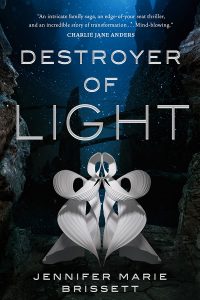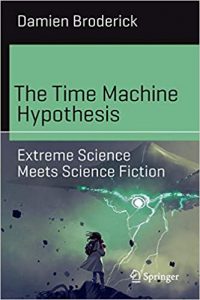Russell Letson reviews William Gibson
William Gibson’s The Peripheral offers a now-familiar blending of close-textured SF and noir/thriller modes, an evolution of the Gibson recipe that reaches back to the very beginning of his career. While Pattern Recognition, Spook Country, and Zero History were minimally science-fictional in their furniture (however much SF feeling they might have wrung out of their could-be-next-week settings), the world evoked by this new book is deliberately and progressively estranged, not only by its genre furniture (around to which we will get eventually), but by the writerly craft with which everything in the story is delivered.
In fact, that craft was the first thing I noticed. The novel is built on a pair of alternating-viewpoint threads. Flynne Bishop is living in a down-at-the-heels semi-rural USA, perhaps a decade or two from now; and Wilf Netherton is a publicist operating in a much more technologically sophisticated and wealthy London. But their viewpoints operate in what an MFA student would recognize as very-close-third-person mode: we know what the viewpoint character does and thinks and no more. Nor is expository data delivered via any of the customary narrative dodges – explanatory injections, as-you-know-Bob conversations, unnecessary briefings – though the first page does take some mercy on us by offering some minimally-orienting information that Flynne would be aware of: that she has a military-veteran brother, Burton, on partial disability; that the munged-up 1977 Airstream trailer he occupies is a valuable, collectible antique. Similarly, a few chapters along, Wilf recalls a conversation that explains part of the strange relationship between his London and Flynne’s America.
But for the most part, sights, sounds, events, and internal reflections are rooted in the right-now, and their contexts, backstories, associations, and significance just accumulate, un-annotated. Wilf’s second chapter, for example, opens with him viewing the camera feed from a ‘‘moby,’’ which has an ‘‘uppermost forward deck.’’ From various cues and clues, we can gather, eventually, that a moby is an airship, though it is not explicitly defined as such. Other lexical items – stub, jackpot, haptics, klept – are similarly left for their natures to become clear through operation or context, or to be worked out via etymology and allusion. (Hint: The ears of connoisseurs of older SF should prick up on ‘‘jackpot.’’)
The world that Gibson has invented here is reasonably intricate, though not so exotic that an experienced reader cannot eventually work out the Ideas behind it and point to examples of similar Ideas from other stories. But understanding must grow gradually, built on a series of hints, observations, and actions. More than 300 pages in, a reasonably synoptic account of some of the background puts most of the pieces together, but by that time it is more a matter of confirmation than revelation. One of the pleasures of this book is the unpacking and assembly of the clues into a coherent world picture: it is a puzzle to be solved, which means that some topics, plot-points, and relationships must remain behind the Spoiler Curtain.
But many other pleasures are available for pointing out and admiring. Chief among them is the noir/thriller/crime-novel side of the book. Looking back through my Gibson files, I see that I have been comparing him to the likes of Charles Willeford, Elmore Leonard, and Carl Hiaasen for a couple decades now. This book does nothing to change my mind about that, and the non-SF spirit that hovers most closely over this book is that of Elmore Leonard, whose demotic, telegraphic style of dialogue it echoes. Here is Flynne being informed by a friend about Burton’s whereabouts after he has gone out to confront something called Luke 4:5:
‘‘Where is he,’’ she asked.
‘‘Homes,’’ he said, ‘‘protective custody.’’
‘‘Arrested?’’
‘‘No. Locked up.’’
‘‘What did he do?’’
‘‘Acted out. Homes were all grinning and shit later. They liked it. Gave him a Chinese tailor-made cigarette.’’
‘‘He doesn’t smoke.’’
‘‘He can swap it for something.’’
‘‘Took his phone?’’
‘‘Homes takes everybody’s phone.’’
This exchange is packed with glimpses of the nature of Flynne’s world that become clearer later. ‘‘Homes’’ is Homeland Security; Luke 4:5 is a band of Westboro Baptist Church-style zealots. These, along with the treatment of tobacco products and phones, the (later) mention of engine exhaust that smells of buttered popcorn or fried chicken, and a dozen other items mentioned in passing, form a mosaic that does not need an expository lump to be effective.
To return to the linear: The storyline is strung across a series of assassinations, attempted or successful, and the efforts to understand and counter who or whatever lurks behind them. It starts when Flynne, filling in for Burton as (she believes) a beta-tester for an on-line game, becomes a virtual – and, as it turns out, the sole – witness to a real murder, in an environment that turns out not to be a game at all. On the other side of the world, Wilf, remote-monitoring an event devised by a celebrity client, is also virtually present at a violent death. When the victim in Flynne’s murder turns out to be the sister of Wilf’s client, their connection brings them to the attention of mysterious forces with opaque agendas as well as London’s potent (and nearly as opaque) law-enforcement establishment.
The protagonists’ connection is entirely virtual, mediated by computational and communication technologies that allow Flynne to inhabit a peripheral – a mindless artificial human body that allows her full sensory access to Wilf’s London. (Wilf at first has to be content with a smartphone connection.) The two clearly inhabit very different worlds. Hers is an unnamed hardscrabble rural town somewhere in the southern US, where the mainstay of the local economy is illegal drug manufacture. (There’s a tempting similarity to the Harlan KY of the Elmore Leonard-inspired Justified.) What commerce remains is dominated by corporate chains with wonderfully tacky trade names (Hefty Mart, Coffee Jones, Pharma Jon, Fabbit), though small businesses do manage to hang on (Jimmy’s Bar, Forever Fab, the Sushi Barn). Lawful employment is available at Hefty Mart or the locally owned fabbing (3D printing) shop, and disabled war vets scrape along on VA benefits. Big brother Burton is one of the latter, physically uninjured but clearly emotionally marked by his tour as a Marine Haptic Scout. His friend Conner, now minus a couple of limbs, wasn’t so lucky.
Wilf’s London is sleek and rich and emphatically science-fictional, with total body modification, nanotechnology, implanted smartphones – in fact, smart everything, from cars to bars, right up to shape-shifting robots called Michikoids – and a power structure that seems to consist mainly of ‘‘klept’’ families (kleptocrats – organized-crime clans like his friend Lev’s) and the cops (in the form of the scarily powerful Detective Inspector Ainsley Lowbeer). This world unfolds just as gradually and indirectly through Wilf’s eyes, as well as through Flynne’s encounters with its strangenesses.
Flynne might be a country mouse, but she’s a very smart one, and from what she sees and hears she is able to piece together an operational understanding of the machineries in which she is caught up. Nor should the street smarts and toughness of her family and friends and neighbors be underestimated, or the military experience of her brother and his fellow vets, even (or especially) the maimed Conner. That back-country ingenuity and determination combine well with the technological resources and special knowledge available from Wilf’s side (though Wilf is mostly dragged along, mystified and wishing for a drink or three), and the result is a series of dramatic, scary, creepy,violent, and finally satisfying confrontations in both settings.
That satisfaction does not depend solely on the winding up of the plot machine (though that machine is admirably devious and its windup is ingeniously definitive) but also on how every scene, every page of the novel is filled with textures and details and observations and inventions and turns of phrase that delight. (Also, lots of those Gibsonian visual images that have become a kind of signature: ‘‘Inside, the trailer was the color of Vaseline.’’) We can enjoy the strenuous fun of decoding the world in which Gibson’s prose deposits us, though without the hazards of dodging the unwelcome attentions of assassins and criminals in high places. And like any really well-designed thrill ride or mystery tour (or sonnet or string quartet), as soon as you get off, you want to get right on for another go-round.










Well done! Thanks especially for the discussion of Gibson’s dialogue style. One thing makes me very curious: what “jackpot” alludes to in earlier SF.
Far as I know it has a connection to Captain Trips , or in other words , world changing events .